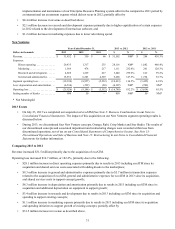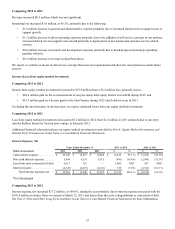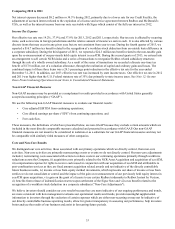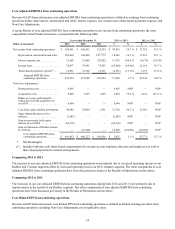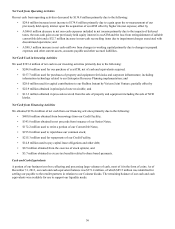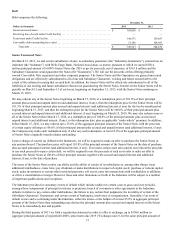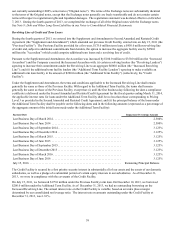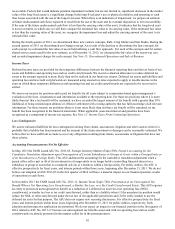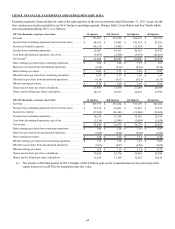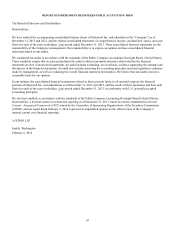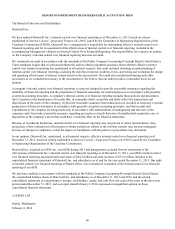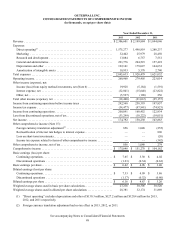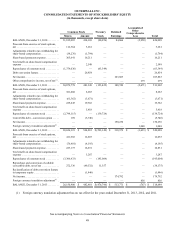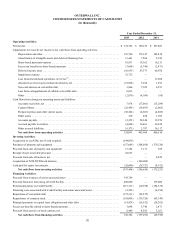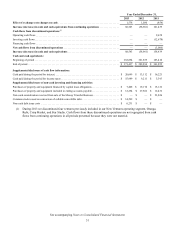Redbox 2013 Annual Report Download - page 50
Download and view the complete annual report
Please find page 50 of the 2013 Redbox annual report below. You can navigate through the pages in the report by either clicking on the pages listed below, or by using the keyword search tool below to find specific information within the annual report.41
Content Library
Content library consists of movies and video games available for rent or purchase. We obtain our movie and video game
content through revenue sharing agreements and license agreements with studios and game publishers, as well as through
distributors and other suppliers. The cost of content mainly includes the cost of the movies and video games, labor, overhead,
freight, and studio revenue sharing expenses. The content purchases are capitalized and amortized to their estimated salvage
value as a component of direct operating expenses over the usage period. Content salvage values are estimated based on the
amounts that we have historically recovered on disposal. For purchased content that we expect to sell at the end of its useful
life, we determine an estimated salvage value. For licensed content that we do not expect to sell, no salvage value is provided.
The useful lives and salvage value of our content library are periodically reviewed and evaluated. The amortization charges
were derived utilizing rental curves based on historical performance of movies and games over their useful lives and recorded
on an accelerated basis, reflecting higher rentals of movies and video games in the first few weeks after release, and
substantially all of the amortization expense is recognized within one year of purchase.
In the second quarter of 2013, the Company completed a review of its content library amortization methodology and updated
the methodology in order to add greater precision to product cost amortization. The previous method recognized accelerated
amortization of content library costs at a rate faster than the decline in the content library's value due to the recognition of
charges in addition to the normal rental curve amortization whenever individual discs were removed from kiosks, a process we
define as "thinning". The Company's most recent analysis has shown that its amortization curves can reasonably capture the
effect of thinning and therefore eliminates the need for additional charges at the time of thinning and provides a better
correlation of costs to revenue. The modified approach to amortizing the cost of the content library is based on updated rental
curves, which incorporate thinning estimates, and provides a more systematic method for recognizing the costs of movie and
game titles.
The Company believes that the change in its content library amortization methodology, made on a prospective basis, is a
change in accounting estimate that is effected by a change in accounting principle. The Company believes that the modified
content library amortization methodology is preferable because it better reflects the pattern of consumption of the expected
benefits of the content library. A copy of our auditor's preferability letter is filed as an exhibit to our 10-Q for the period ended
June 30, 2013.
The effect of this change resulted in a reduction of product costs, as reported in direct operating expenses, of approximately
$21.7 million in the second quarter of 2013, with those costs shifted to primarily the third and fourth quarters and some into
2014. The change resulted in a corresponding increase to the balance of our content library. In addition, the change in
amortization methodology shifted product costs on titles purchased during the second half of 2013 into 2014 as amortization is
less accelerated than under the prior method. Under the modified amortization methodology, substantially all of the
amortization expense will continue to be recognized within one year of purchase. For year ended December 31, 2013, the
change resulted in a total pretax benefit of $31.8 million or $1.17 per basic share and $1.12 per diluted share.
Goodwill
Goodwill represents the excess purchase price of an acquired enterprise or assets over the estimated fair value of identifiable
net assets acquired. We assess goodwill for potential impairment at the reporting unit level on an annual basis as of
November 30, or whenever an event occurs or circumstances change that would more likely than not reduce the fair value of a
reporting unit below its carrying amount. We may assess qualitative factors to make this determination, or bypass such a
qualitative assessment and proceed directly to testing goodwill for impairment using a two-step process. Qualitative factors we
may consider include, but are not limited to, macroeconomic conditions, industry conditions, the competitive environment,
changes in the market for our products and services, regulatory and political developments, entity specific factors such as
strategies and financial performance. If, after completing such assessment, it is determined more likely than not that the fair
value of a reporting unit is less than its carrying value, we proceed to a two-step impairment test, whereby the first step is
comparing the fair value of a reporting unit with its carrying amount, including goodwill. If the fair value of a reporting unit
exceeds its carrying amount, goodwill of the reporting unit is considered not impaired and the second step of the test is not
performed. The second step of the impairment test is performed when the carrying amount of the reporting unit exceeds the fair
value, then the implied fair value of the reporting unit goodwill is compared with the carrying amount of that goodwill. If the
carrying amount of the reporting unit goodwill exceeds the implied fair value of that goodwill, an impairment loss shall be
recognized in an amount equal to the excess. For additional information see Note 5: Goodwill and Other Intangible Assets.
Lives and Recoverability of Equipment and Other Long-Lived Assets
We evaluate the estimated remaining life and recoverability of equipment and other assets, including intangible assets subject to
amortization, whenever events or changes in circumstances indicate that the carrying amount of the asset may not be


